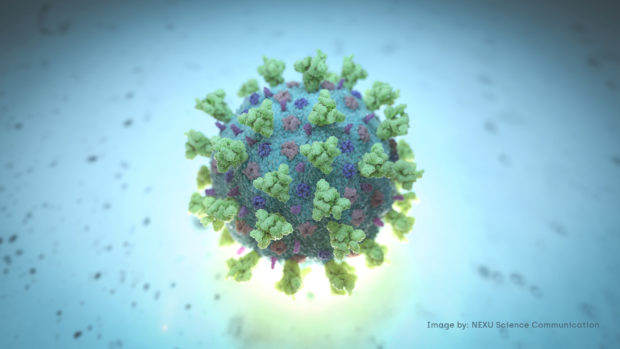
FILE PHOTO: A computer image created by Nexu Science Communication together with Trinity College in Dublin, shows a model structurally representative of a betacoronavirus which is the type of virus linked to COVID-19, better known as the coronavirus linked to the Wuhan outbreak, shared with Reuters on February 18, 2020. NEXU Science Communication/via REUTERS
MANILA, Philippines — Independent pandemic monitoring organization Octa Research on Thursday described as “concerning” the current COVID-19 situation in Metro Manila, although the metropolis remained under the “low risk classification.”
This development came after the National Capital Region (NCR) recorded an increase in positivity rate of 2.2 percent on Wednesday, compared to 1.5 percent a week ago, according to Octa Research fellow Guido David.
“The situation in NCR has become more concerning as the positivity rate, at 1.5 [percent] a week ago, has increased to 2.2 percent as of June 8, 2022,” David said in a bulletin posted on Twitter.
However, Metro Manila’s current positive rate is still well within the World Health Organization’s ideal positivity rate set at five percent.
The reproduction number (R0) of the metropolis also increased from 1.15 on May 31 to 1.29 as of June 6, David added.
The R0 (pronounced as r-naught) indicates how infectious a disease is. For instance, an R0 of 1 means that each carrier can transmit the virus to one person. The current R0 of 1.29 meant that each existing infection would cause more than one new infection.
The seven-day average of new cases in Metro Manila increased by 28 percent to 102.
“The last time the seven-day average was above 100 was on April 8,” David also said.
Also increased are the hospital bed occupancy for COVID-19 in the metropolis: from 1,372 beds occupied or 21 percent on June 5, to 1,520 beds occupied or 24 percent on June 8. David said this is equivalent to 50 additional beds occupied per day for the past three days.
David, when asked by a Twitter user if the numbers means that the region is expecting a surge, said: “It is still not clear what it would be at this time. For now I would say that at worst, it could be a weak surge, but that can also change.”
So far, the new Omicron subvariants
David previously said that the new subvariants may cause another surge in COVID-19 cases once it entered the country, but it would not be as high as the cases recorded in January due to the Omicron variant.
RELATED STORY:
JPV
Subscribe to our daily newsletter
Read Next
Subscribe to INQUIRER PLUS to get access to The Philippine Daily Inquirer & other 70+ titles, share up to 5 gadgets, listen to the news, download as early as 4am & share articles on social media. Call 896 6000.
For feedback, complaints, or inquiries, contact us.
Subscribe to our daily newsletter
By providing an email address. I agree to the Terms of Use and
acknowledge that I have read the Privacy Policy.


